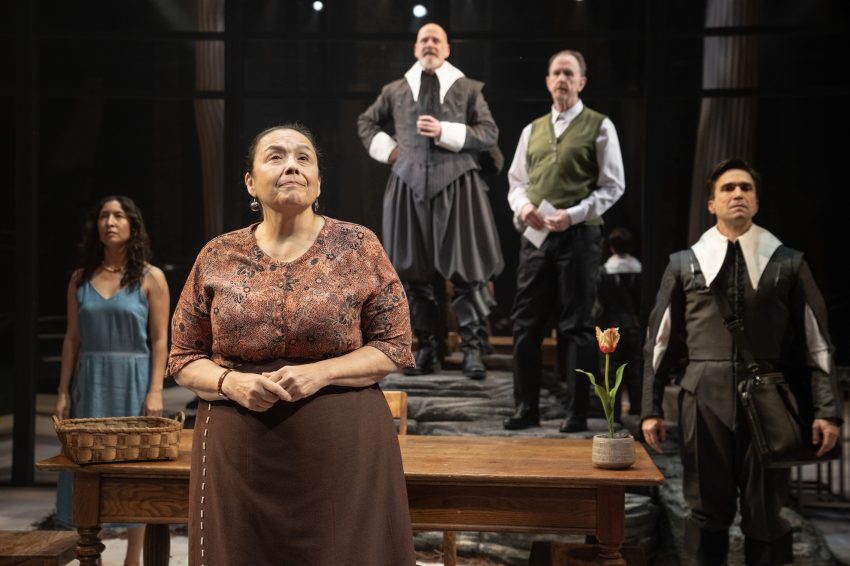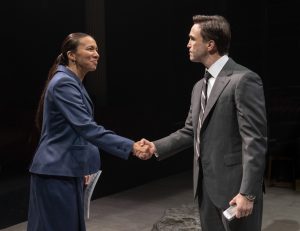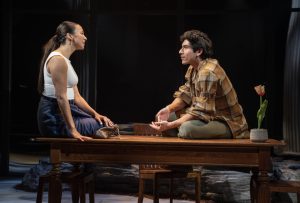
“Manahatta” Shines Limelight on Native Americans—at The Public
Millennial Notes
Mary Kathryn Nagle Exposes Native History vs. Wall Street
by Tanvi Agrawal
Mary Kathryn Nagle’s “Manahatta” at the New York Public Theater depicts a tragic, reverse homecoming. Jane, a modern day descendant of the Lenape people, leaves her home in Oklahoma for a fancy job on Wall Street. When she tries to return to the West, she is not welcome back.
“Machi Manahatta!” her sister says, meaning “go home to Manhattan!” in the native language of the Lenape people, who lived for thousands of years on Manhattan Island.
Nagle splits her scenes between NYC in the mid-1600s, the era of Dutch colonization, and the late 2000s. She draws parallels between the exploitation of Lenape people in the 17th century and the 2008 financial crisis. In the recent crisis, unaware homeowners, including Native, defaulted on their loans.
Similarly, Nagle spotlights the early Dutch colonizers’ physical and financial massacre of Native Lenape people. By presenting the two eras, Nagle shows us what a clear, pro-Native awareness looks like.
Audiences arrive to find a humble office setting, complemented by a pair of realistic boulders upstage. The back wall is made of mirrors that will reveal secrets later, while also cleverly reflecting both audiences’ and actors’ faces.

The show begins explosively with Jane Snake (levelheaded Elizabeth Frances), a Lenape woman with a Stanford MBA, being interviewed for a fancy Wall Street job. A fast-talking financier taunts, “How bad do you want it?” Jane responds, “My father is having open heart surgery right now, and I’m here.” She gets the job on the spot.
Director Laurie Woolery capitalizes on Nagle’s “split scenes” by rapidly alternating action between chaos on Lenape land in Oklahoma and Jane’s career on Wall Street.
As Jane rises in the financial world, her mother sinks into medical debt. At the height of the conflict, Nagle expertly interweaves the stories of Jane’s mother Bobbie (wry Sheila Tousey) who loses her home; while in 1600, we see Dutch settlers forcing the Lenape from their Manahatta.

While Jane delivers earnings calls on behalf of Lehman Brothers, a failing financial giant, her ancestors are being senselessly slaughtered. The talented Frances also plays Jane’s great grandmother, who smears the red blood from her husband’s massacre by the Dutch on her white pants. As Jane, she carries that stain till the end.
The conflict comes to a head when Jane travels home to Oklahoma. She finds her mother and sister packing so that the house can be auctioned. “How could you not tell me we’re losing our home?” cries Jane. “We’re losing our home. You’re losing a memory!” her sister snaps back.
Jane writes a big check to buy the home. But her mother tears it up, saying she’d rather have a stranger buy it. She does so not out of spite but to make a point: “They can try [to take our home] but they can’t take everything, because when we leave, we take home with us.
This show really makes us think about Manhattan’s diaspora history. Everyone who sees “Manahatta” learns truths about the stealing of this country. Nagle decidedly celebrates the Native Americans upon whose sacred lands we live now.

”Manahatta” by Mary Kathryn Engle, directed by Laurie Woolery, scenic design by Marcelo Martinez Garcia, costume design by Lux Haac, lighting design by Jeantee Oi-suk Yew, at The Public Theater, New York City.
Info: publictheater.org – to December 23, 2023.
Cast: Rainbow Dickerson (Toosh-ki-pa-kwis-i / Debra), Elizabeth Frances (Le-le-wa’-you / Jane), David Kelly (Jonas Michaelius / Michael), Jeffrey King (Peter Minuit / Dick), Enrico Nassi (Se-ket-tu-may-qua / Luke), Joe Tapper (Jakob / Joe), and Sheila Tousey (Mother / Bobbie).
Banner photo: Rainbow Dickerson, Sheila Tousey, Jeffrey King, David Kelly, and Joe Tapper. Photos: Joan Marcus